We explore the top 10 aquarium plants that thrive without substrate, offering a range of options from the easy-to-care Java Moss to the fast-growing Riccia Fluitans. These plants, including the versatile Anubias and the light-dependent Duckweed, provide aesthetic appeal and practical benefits in aquariums, even for beginners. Our guide also touches on factors like size, color, and lighting, vital for selecting the right plants to complement your aquascaping ambitions.
If you happen to be new in aquascaping, you probably have thought about getting some plants too.
Keeping aside the debates, having plants in an aquarium can serve you with many benefits. Yes, plants can do much more than just make it look pretty.
However, no one is saying that plants are very necessary for your fish in the tank, but still, if you are interested in buying some plants, this article is for you!
In this article, we will tell you about the best aquarium plants that do not require substrate. There are numerous live plants out there with beautiful colors and variant sizes.
So, let’s start – here are our top 10 aquarium plants that don’t need substrate.
Table of Contents
10 Best Aquarium Plants That Don’t Need Substrate
Here is a list of some common aquarium plants that do not require a substrate:
- Java Moss
- Hornwort
- Java Fern
- Anubias
- Water Lettuce
- Green Cabomba
- Anacharis
- Duckweed
- Amazon Frogbit
- Riccia Fluitans
Best Aquarium Plants That Don’t Need Substrate
Now it is time to look at the top 10 aquarium plants that don’t need substrate –
#1 Java Moss
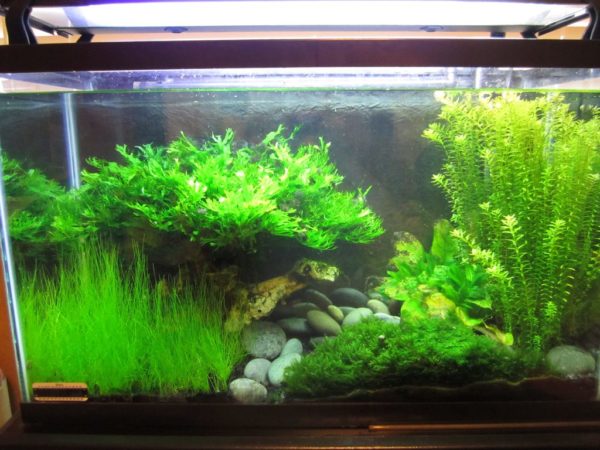
About
- Plant: Java Moss
- Scientific Name: Vesicularia Dubyana
- Level of Care: Basic and Easy
- Requirement of Light: Low to Bright
- Rate of Growth: Moderate to Fast
- Temperature: 59 degrees to 86 degrees Fahrenheit
- pH: 5.0 – 8.0
- Hardness: 60 to 240 ppm
- Placement: Foreground
- Max Size: 4”
- Min. Tank Size Required: 5+ gallons
If you are looking for plants to put in your tank, no doubt the Java Moss is one of the best choices you make. Plants of this type do not require the substrate to grow.
Aquarists prefer this plant for many reasons. The Java Moss is pretty versatile. You can grow Java Mosses and sell them to some people who need one or at your local store. Java Mosses are very beneficial for breeding purposes as these plants provide enough cover for the younglings to hide in.
Especially if you are into aquascaping, you know using rocks, plants, woods, and other modifications make your aquarium look incredibly beautiful. However, you can uplift the appearance by showering some lights from the top.
Mosses can be used in numerous ways, and you can use them as a foreground plant, and also, you may tie them to the rocks and woods.
#2 Hornwort
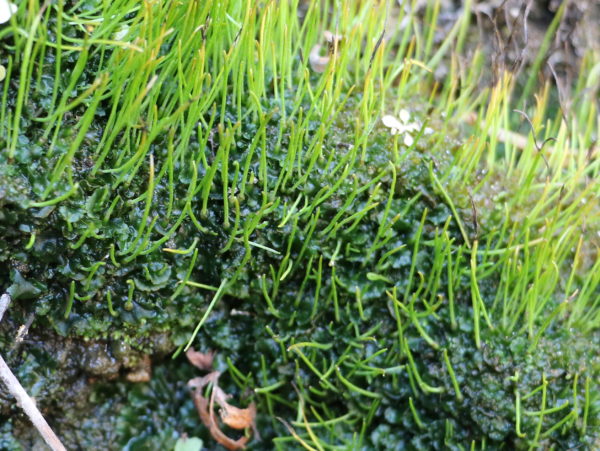
About
- Plant: Hornwort
- Scientific Name: Anthoceratophyta
- Level of Care: Easy
- Requirement of Light: Moderate
- Rate of Growth: Fast
- Temperature: 59 degrees to 86 degrees Fahrenheit
- pH: 6.0 – 7.5
- Hardness: 5 to 15 dGH
- Placement: Background
- Max Size: 10 Feet
- Min. Tank Size Required: 15+ gallons
Hornwort is a super tall aquarium plant that can grow up to 10 feet long. The hornwort is a pretty popular plant among fish-keepers as these are often known as the best oxygenating plants.
If you happen to be a beginner in this, the hornwort can prove to be pretty beneficial for you as these plants can have a high tolerance range for water parameters. This plant grows pretty fast, and it is very easy to maintain.
The hornwort grows fast because of its allelopathic abilities. Hornwort releases special chemicals that prevent other plants from growing in their surroundings and getting all the sufficient nutrients it needs to grow.
The hornwort requires low light. However, hornwort needs light to grow. The more amount of light it gets, the faster and greener it gets.
If you want optimum growth, fix a moderate light in the tank. Do not put this plant in the shade.
#3 Java Fern
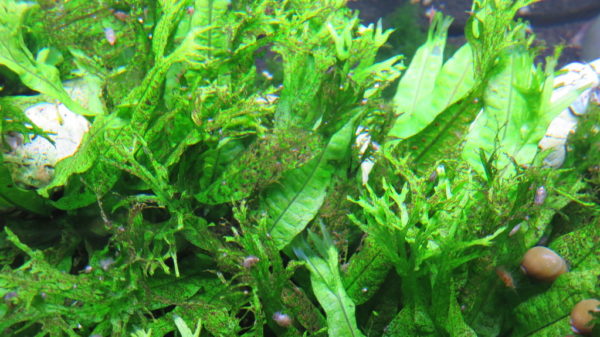
About
- Plant: Java Fern
- Scientific Name: Microsorum Pteropus
- Level of Care: Easy
- Requirement of Light: Moderate
- Rate of Growth: Moderate
- Temperature: 68 degrees to 82 degrees Fahrenheit
- pH: 6.0 – 7.5
- Hardness: 60 to 160 ppm
- Placement: Middle to Background
- Max Size: 13.5”
- Min. Tank Size Required: 5+ gallons
If you are into aquascaping for some time, I am sure that you have come across this one. The Java Fern is one of the most popular plants for aquascaping.
The java fern is a hardy plant that can be grown from 8 inches to 13 inches. These plants are super easy to take care of and tend to have higher tolerance when it comes to different water parameters. These plants are cost-effective, and you can get them at your nearest fish store.
Java ferns grow the best when under low-moderate lights. Generally, these are tied or glued to rock or wood pieces in the tank. This plan directly fetches its share of nutrients from the water.
It is better to have plants that require no substrate to grow, especially when you plan on modifying the tank’s décor each time you clean it.
All you have to do is simply tie the plants to some pieces of wood or rocks, shower some lights, and the magic has been done.
#4 Anubias
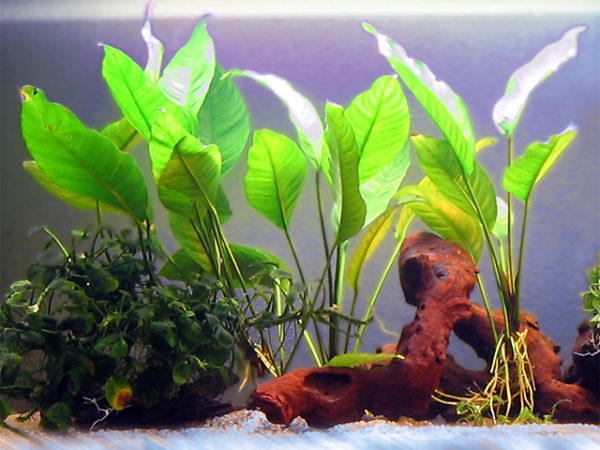
About
- Plant: Anubias
- Scientific Name: Anubias
- Family: Araceae
- Level of Care: Easy
- Requirement of Light: Moderate
- Rate of Growth: Slow
- Temperature: 72 degrees to 82 degrees Fahrenheit
- pH: 6.5 – 7.8
- Hardness: 60 to 160 ppm
- Placement: Mid – Background
- Max Size: Greater than 11”
- Min. Tank Size Required: 5+ gallons
When the talking is about the best aquarium plants, how would anyone miss Anubias? This plant is known widely for its versatility.
This plant is the best for beginners in this hobby. Anubias have a comparatively slower growth rate, but if you are able to provide them with sufficient nutrients, they will grow at a moderate speed.
This plant does not have a high demand for lights as it is able to survive in any light condition. If you can keep a low light fixture, or if you wish, you can keep heavy lights. However, low light is preferred even after it grows pretty slow, but having high and powerful lights will promote the growth of algae on its leaves. Hence, you know which light to keep.
Anubias is one of the top picks because it does not require substrate. All you have got to do is tie it with any wood or rock piece.
#5 Water Lettuce
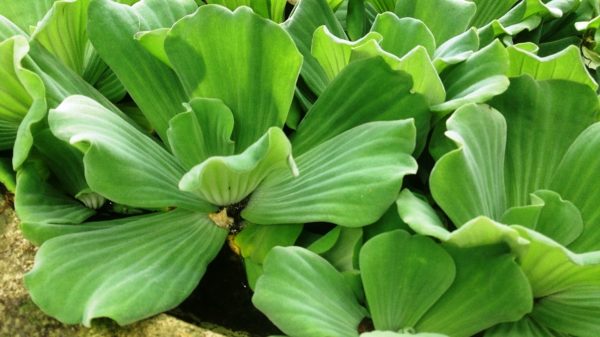
About
- Plant: Water Lettuce
- Scientific Name: Pistia
- Family: Araceae
- Level of Care: Moderate
- Requirement of Light: Moderate
- Rate of Growth: Moderate
- Temperature: 70 degrees to 80 degrees Fahrenheit
- pH: 6.5 – 7.2
- Hardness: Moderate but soft
- Placement: Water surface
- Max Size: 10”
- Min. Tank Size Required: 10+ gallons
When looking for plants that grow without the need for substrates, the water lettuce is among them. And interestingly, the water lettuce is a floating plant.
This plant was first found in the Nile near Victoria Lake. After it was discovered, this grew so fast that now it is a potential threat to native aquatic vegetation and life.
In some states, it is banned to carry water lettuce. So, you have to get on with research if these are allowed in your state.
There is much hassle involved when it comes to growing water lettuce in an aquarium, and so it is not a good choice for newbies as well.
The prime requirement of this plant is humidity; yes, the water lettuce needs a lot of humidity to grow. And it needs moderate to low lighting.
If you are able to provide it with the ideal environment, this floating plant can grow pretty fast. But you might not want to do that.
#6 Green Cabomba
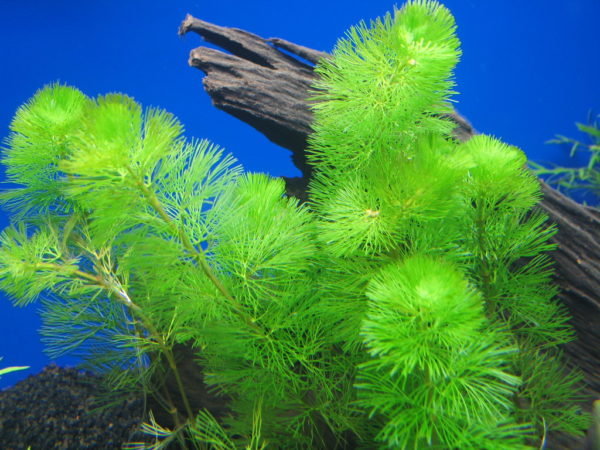
About
- Plant: Green Cabomba
- Scientific Name: Cabomba Caroliniana
- Family: Cambombaceae
- Level of Care: Moderate
- Requirement of Light: Moderate to High
- Rate of Growth: Fast
- Temperature: 72 degrees to 82 degrees Fahrenheit
- pH: 6.8 – 7.5
- Hardness: 3 – 8 KH
- Placement: Background / Floating
- Max Size: 11”
- Min. Tank Size Required: 10+ gallons
The green Cabomba is slowly attracting the mainstream media, and its popularity is significantly rising among the aquarists. The green Cabomba is widely known as Brazilian fanwort and also goes by the name Carolina fanwort.
This plant is growing really fast, and it can be as tall as Anubias. Yes, this plant can grow 11” tall.
Honestly, the green Cabomba is a bit tricky to care for and maintain, so if you happen to be a beginner, you should not opt-in for this plant. The green Cabomba are very delicate aquatic plants.
Also, you need to make sure that you do not own any plant-eater fish in the tank. If you own such fish, then you should keep yourself from buying this.
The green Cabomba requires light from moderate to high range. This plant is dependent on light for its growth: requirements – 3 watts per gallon.
All you have to do is just let it float.
#7 Anacharis
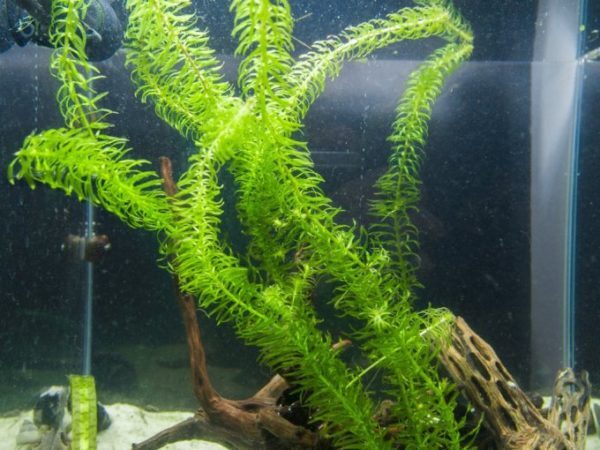
About
- Plant: Anacharis
- Scientific Name: Elodea
- Level of Care: Easy
- Requirement of Light: Moderate
- Rate of Growth: Fast
- Temperature: 60 degrees to 82 degrees Fahrenheit
- pH: 6.5 – 7.5
- Hardness: 3 – 8 KH
- Placement: Background
- Max Size: 6 – 8 inches
- Min. Tank Size Required: 10+ gallons
After the green Cabomba comes to the Anacharis, it is another famous tank plant preferred by many aquarists.
This plant is famously termed Egeria, Brazilian waterweed, and Brazilian Elodea. This plant is considered ideal for many newbies as the Anachais can endure many water parameters efficiently.
Additionally, the anacharis can stand a low temperature of 60 degrees, so if your fish like to stay in cold water, you can use the anacharis as a décor.
Anacharis requires moderate lighting, or you can calculate it like this – 2 watts of light per gallon. Here, you have to be very careful because if you provide it with low light, it is going to die, and if you shower some highlights, chances are you will see algae formation on its leaves.
If you have this plant, you have two choices. First, you can let it float on the water surface, and second, you can tie it with the woods and rocks.
#8 Duckweed
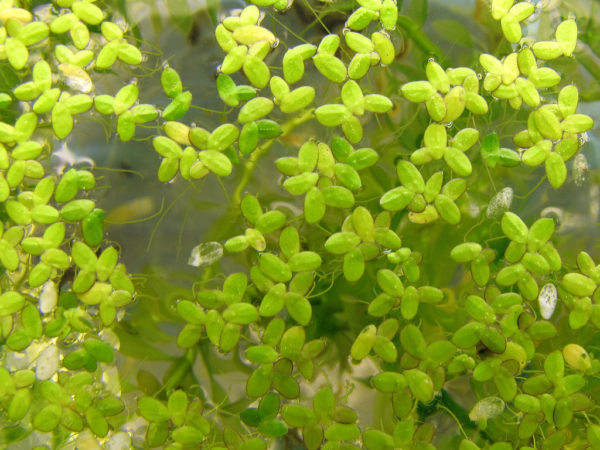
About
- Plant: Duckweed
- Scientific Name: Lemnoideae
- Level of Care: Easy
- Requirement of Light: Low to High
- Rate of Growth: Fast
- Temperature: 42.8 degrees to 91.4 degrees Fahrenheit
- pH: 5.0 – 9.0
- Hardness: 17 to 180 ppm
- Placement: Water Surface (Floating)
- Max Size: Each pod measures 0.8”
- Min. Tank Size Required: 2+ gallons
Looking for low-maintenance plants that do not require any substrate? Then the duckweedDuckweed is the choice to make.
However, you will have many opinions about duckweeds, but if you keep its growth in control, then there are definitely some benefits of having this plant in the tank. Like, the duckweedDuckweed acts like a great water purifier for the tank.
However, if you fail to keep its growth in check, it will be of humongous size in terms of the aquarium and will result in decreasing the oxygen level and block the lights.
It can be tricky to keep this plant as it requires a greater amount of light to grow. And it can endure various water parameters.
To use décor, you have to let it float on the surface as you know it is a floating type plant.
#9 Amazon Frogbit
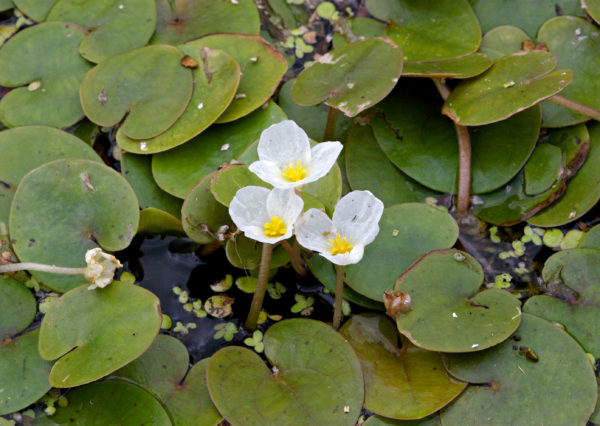
About
- Plant: Amazon Frogbit
- Scientific Name: Limnobium Laevigatum
- Level of Care: Easy
- Requirement of Light: Moderate
- Rate of Growth: Fast
- Temperature: 64 degrees to 84 degrees Fahrenheit
- pH: 6.0 – 7.5
- Hardness: 220 – 240 ppm
- Placement: Water Surface
- Max Size: 20”
- Min. Tank Size Required: 10+ gallons
The amazon frogbit famously goes by the name of the South American sponge plant because its leaves resemble the shape of a sponge.
The Amazon Frogbit is a super-fast growing plant and has comparatively lower maintenance. It is easy to take care of this plant, and so you see, it is one of the ideal aquarium plants for newbies.
However, you need to install moderate to high-level lights if you want your plant to grow properly. You can use fluorescent or LEDs. This plant needs soft water or moderately hard water.
The amazon frogbit is a floating plant. All you have to do is just allow it to float on the surface.
#10 Riccia Fluitans
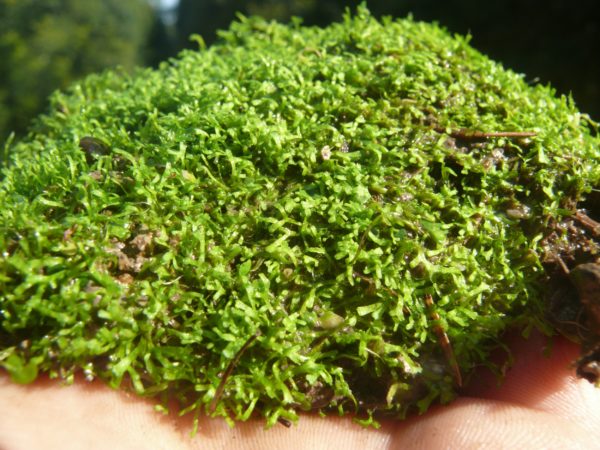
About
- Plant: Riccia Fluitans
- Scientific Name: Riccia Fluitans
- Family: Ricciaceae
- Level of Care: Easy
- Requirement of Light: Moderate
- Rate of Growth: Fast
- Temperature: 56 degrees to 86 degrees Fahrenheit
- pH: 6.0 – 8.0
- Hardness: Moderately soft water to very hard water
- Placement: Foreground
- Max Size: 1.9”
- Min. Tank Size Required: 10+ gallons
The Riccia Fluitans is popularly known as the Floating Crystalwort. This particular plant began attracting mainstream attention when the famous Takashi Amano started aquascaping with this plant.
Famous aquarist Takashi Amano featured the fluitans in his tanks. Now, the fuiltans are primarily Mosses, like the Java Moss.
The riccia fluitans are pretty easy to maintain and take care of. These plants are beginner-friendly as these can endure variant types of water parameters. And the best part is you can let them float on the surface or tie them with the aquarium props.
These plants require moderate lights for their proper growth.
Bonus – we suggest you keep it tied because these plants tend to grow faster when floating. However, keeping it this way will need more supply of lights, like – 3 watts of light per gallon.
Also Check: 10 Freshwater Aquarium Plants
Buying Guide
Before Buying We emphasize considering factors such as the size and color of plants in relation to the aquarium, the manageability of the plants, and the lighting requirements for live plants. These factors are crucial for ensuring the plants fit well in the aquarium, are easy to maintain, and receive adequate light for growth and health.
Buying an aquarium plant does not mean walking up to a fish store and getting the plant you want. There are quite a few factors that you need to take into consideration. These factors are –
Size
The first thing that you need to pay attention to is the size of the tank. You need to look for a plant that balances size and height in terms of the aquarium.
Fish needs plenty of space to swim and play around, and they would not like to feel like they are trapped in the aquarium.
Color
Another factor affecting your choice is the color of the plants. Well, it depends on you how you want your aquarium to look.
Some aquarists like the natural scenery in the tank, while some spend grands in getting their tanks decorated.
Manageability
If you think it is easy to clean a tank, we want you to give it a second thought. If you are looking for aquarium plants, you should look for plants that are easy to manage.
You would not want to indulge yourself in a daunting task. Or, you could simply opt-in for artificial plants. These require no substrate, and the care level is equal to 0.
Lighting
If you plan to put some live plants in the tank, then let me tell you that the live plants have sufficient light to survive.
The light fixtures in the tank act as the prime source of energy as the light helps the plants to complete the process of photosynthesis.
Live plants need 8 hours of full-spectrum light every day!
The aforementioned factors are to be considered when buying a live plant for your aquarium.
Also Read: Pothos Plants In Aquariums
Frequently Asked Questions
There are numerous plants that can grow in sand. Plants like – Java fern, giant hygro, Amazon sword jungle, etc.
Yes, aquarium plants can grow without the requirement of soil. At the same time, some can even grow in gravel or sand. Furthermore, there are plants that do not need any substrate.
The maximum number of plants that do not need substrate are basically floating plants.
Conclusion
Now that you have read this write-up here, I hope you have made your choice. As you have seen, we have provided you with our best plants that don’t need substrate. Also, we have compiled a short buying guide for you in case you need any help.
I hope this article proved to be resourceful for you. Once again, do consider the size of the tank and other factors before buying a plant.
Good luck with all the aquascaping you have got to do.
Check Our New Article: Best Housing Plants for Aquaponics Fish Tank
